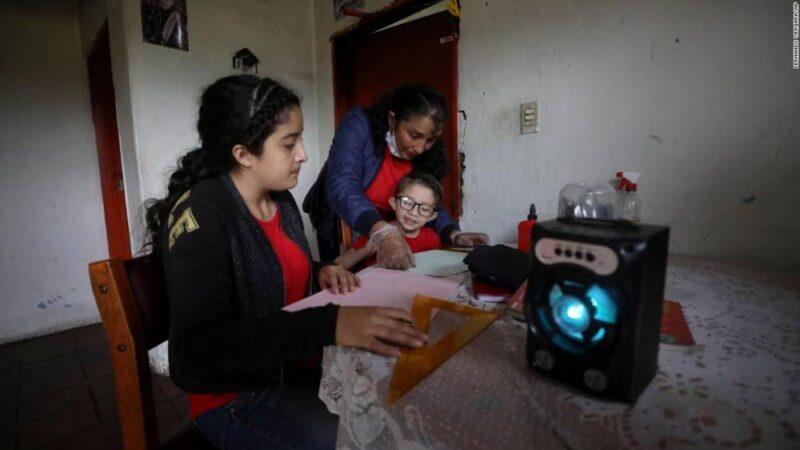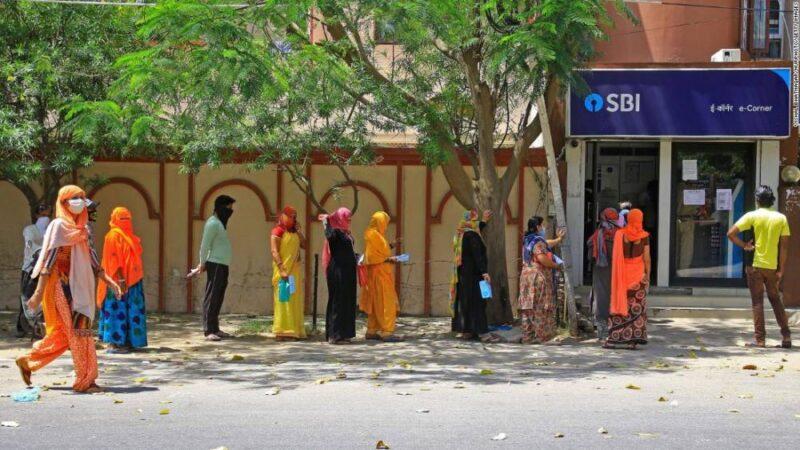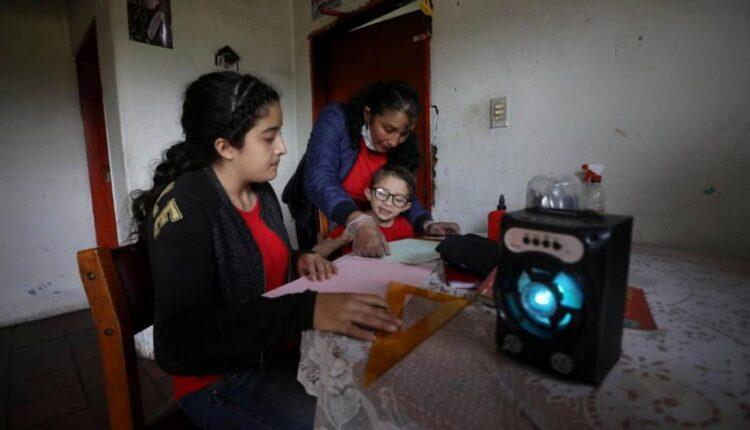(CNN)When the coronavirus pandemic began to spread through Colombia, creeping its way to the town of Uribia, the only information Angela Montiel could get about Covid-19 was from her neighbors.
They told her a deadly virus “like a whooping cough” was gripping the country and had even hit the nearby city of Maicao. But she was skeptical it was so close to home. “I don’t know if this is true,” said 38-year-old Montiel, who is part of the country’s largest indigenous group, the Wayuu. As much of the world locked down at home in recent months, billions watched the coronavirus crisis unfold through a seemingly universal window: the internet. But billions of other people don’t even have access to the internet. Montiel is one of them.
When the Colombian government issued a nationwide lockdown in late April, she and her husband were advised to stay at home with their three children, keep their distance from other people, wash their hands and wear masks to avoid the virus, which has killed more than 400,000 people around the world.But for the Montiels, the stay-at-home order is its own sort of death sentence. Read MoreBefore the lockdown, Angela would occasionally top up a SIM card in order to use WhatsApp, but hasn’t been able to recharge it since the lockdown. With no internet connection, there is no way to “work remotely.” Angela knits traditional Wayuu mochila bags but she can’t sell them in the street under the current restrictions. For now, her family has been surviving off emergency cash payments from the non-governmental organization Mercy Corps. It’s impossible for her children to continue their education from home without access to school materials online. As for updates, they wait for phone calls from friends or family, who might bring news. Otherwise, they’re in the dark.”Seeing as we don’t have TV, internet or anything, we don’t know if it’s still going on or if it will keep going, so obviously we can’t go out or move around,” Montiel said. “We’re in despair.”

A family listens to an hour-long radio lesson from their home in Funza, Colombia, where they have no internet connection.According to UN estimates, nearly half the global population — 46% — still aren’t connected to the internet. For those people, lockdown means missing out on immediate access to vital public health information, remote work opportunities, online learning, telemedicine appointments, digital grocery deliveries, live-streamed religious services — weddings, and even funerals — as well as the countless other ways we are increasingly living our lives online.Governments around the world have committed to providing universal access by 2020, but the digital divide still runs deep and is widening inequalities offline as well. People in poorer regions are less likely to be connected, as are women, elderly people and those living in remote or rural areas. And in many cases, connectivity can be tenuous — closures of offices, schools or public spaces, like libraries and cafes, have cut access off for many.”We’ve always said that there are about 3.5 billion people who are not connected, but we know it’s more now, because quite a number of the people who used to be connected at their workplaces and other public spaces no longer have that access,” said Eleanor Sarpong, the deputy director at the Alliance for Affordable Internet (A4AI). “Covid-19 has shown that there’s such a huge divide, and it’s actually come as a shock to some governments. When they asked their employees to go work from home … a lot of them couldn’t.”Sarpong is hopeful the crisis will break through long-existing barriers to internet access — from a lack of political will to regulatory hurdles and data affordability — to get more of the world connected.A4AI, an initiative of the World Wide Web Foundation, founded by Tim Berners-Lee, recently shared a set of policy recommendations, urging governments, companies and civil society to take urgent actions to bring as many people online as possible during the pandemic. Among their immediate recommendations are: removing consumer taxes on internet services; cutting out data charges for public websites; providing affordable data packages; expanding broadband allowances; and rolling out free public wifi infrastructure. Some are already taking these steps.”Governments need to look at internet access, not as a luxury, but to see it as an enabler that can transform their economies … I think it’s a wake-up call for them,” Sarpong said.
A digital gender gap
Digital technologies have rapidly revolutionized life as we know it. But not everyone is benefiting equally, and many are getting left behind because of a lack of infrastructure, literacy and training.Across the world’s least-developed countries, just 19% of people are online. Men are 21% more likely than women to be connected — and that gender gap is only widening.In India, an aggressive approach towards digitization has moved most government benefits online — from rations to pensions. Even before the pandemic, the country’s poorest were dependent on digital, despite half of the population being offline.The pandemic has only magnified the irony of that situation. When the crisis hit and India’s 1.3 billion people were placed under lockdown, the nation’s informal economy ground to a screeching halt. So when the government announced it would send direct cash transfers to vulnerable women, widows, senior citizens and disabled people for three months starting April 1, it was welcome news. But, stuck at home without smartphones, many were unable to access the 500 to 1,000 rupees ($6 to $13) in aid.

People wait outside a bank during lockdown in Jaipur, Rajasthan, India, on April 9.Lal Bai, a 65-year-old widow living in a remote village in Rajasthan, couldn’t trek the five miles into the nearest town to withdraw the government cash, and had no means of accessing the government funds online, so she quickly found herself without any food left at home. Distraught, Bai ended up on the doorstep of Ombati Prajapati, who runs a digital services shop in her village. “She was the only one who would help me.”Prajapati is among 10,000 “soochnapreneurs,” or digital entrepreneurs, who have been trained and supported by Digital Empowerment Foundation (DEF), a New Delhi-based NGO, in rural parts of the country. Amid the lockdown, they’re helping provide essential digital services, including remote banking that allows people like Bai to withdraw cash using a mobile, biometric ATM. And they’re even helping to fight misinformation.”It is only because of the internet that I am able to see what is happening and tell others that they should regularly wash their hands with soap, use sanitizer, wear masks,” said Prajapati, 27. “I would not have been able to help any of these people [if I had not learned how to use the internet]. I would not have been able to even help myself.” Osama Manzar, a social entrepreneur and DEF’s founder, says that their work training women like Prajapati has shown how important it is to have digital infrastructure available to the last mile — especially during a disaster.”Connectivity and access to the internet must be part of basic human rights. It must be considered, at the time of pandemic and disaster, just as you provide access to food or water, there must be a way to provide access to data,” Manzar said.
A problem for rich countries, too
The digital divide has long been thought of as a development issue. But the pandemic has highlighted that wealthy countries are also afflicted by digital deprivation. More than four in 10 low-income households in America don’t have access to broadband services, according to research by Pew. And in the United Kingdom, 1.9 million households have no access to the internet, while tens of millions more are reliant on pay-as-you-go services to get online. “Sometimes people talk about Covid-19 as being a great leveler. But actually, the way that people are experiencing the lockdown is not at all equal,” said Helen Milner, the chief executive of the Good Things Foundation, a UK charity working with the government to get more people online. “Digital exclusion is, for a lot of people, just an extension of social exclusion that they’re facing, and poverty is definitely part of that.”The British government recently launched a number of initiatives to help try and tackle digital exclusion. Among the schemes is a new campaign, DevicesDotNow, which asks businesses to donate devices, sims and mobile hotspots. Good Things Foundation is helping deliver the devices to those in need, and assisting with training. So far, they’ve given out around 2,000 tabletsAmong the recipients was Annette Addison, who lives alone in a flat in Birmingham, central England and uses a wheelchair to get around. Before the lockdown, she would go to her local community center to access the internet and get assistance with her disability payments. But without a smartphone, she says she has felt isolated and in the dark about the status of her benefits.”I wasn’t coping at all. I was very lonely and depressed when lockdown first started, but since I’ve had the tablet … when I’m feeling lonely, I can talk to my grandchildren or my daughter. I’ve got contact with them constantly, because they’re always online.”On May 1, Addison turned 60. She celebrated with her grandchildren over a video chat on her new iPad — the same iPad she now uses to check her benefits portal. And she’s recently signed up for a dating site too. “I feel like a teenager,” she said.But, as governments try to roll out digital services to the neediest, the question remains: Who gets a device and who doesn’t?Hafsha Shaikh, founder of SmartLyte, the digital skills center that distributed the device to Addison, said that is a question that haunts her.
“That device isn’t just about immediate support during Covid, but it’s about opening up the gateway, for parents and for families, to aspirations and opportunities,” Shaikh said. There are currently 1,500 others on the waiting list in her area.”The biggest challenge is, who do I choose?”
Source: edition.cnn.com

